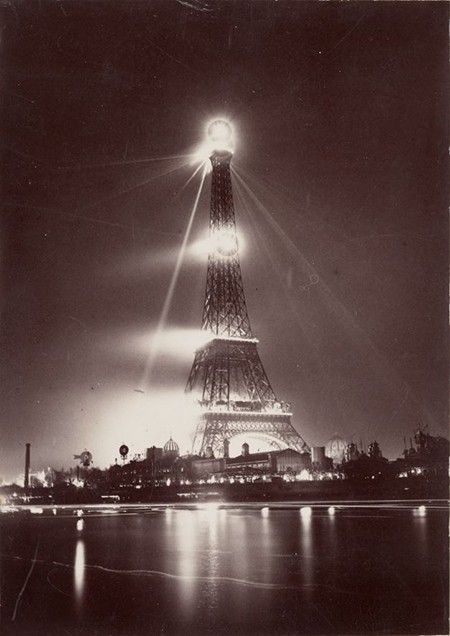La Tour Eiffel—the 300-meter openwork four-footed iron pylon that was the tallest structure on earth when erected in Paris in 1889 for the Exposition Universelle, held to mark the centenary of the French Republic—continues to pose questions despite its global fame and the abundant scholarship it has inspired. In 1964 Roland Barthes declared, “There is virtually no Parisian glance it fails to touch at some time of day. . . .The Tower is also present to the entire world.” My project, inspired by Barthes’s assessment of its twofold visibility, considers a targeted aspect of what I call the tower’s inescapability: the connection of its illuminations to its visibility and reception.
My study has three primary objectives: explaining the technology and purpose of the tower’s everyday lighting then and now (alongside but distinct from its spectacular illumination for special events); analyzing the practices that determine its identity as the French capital’s metonym if not surrogate body; and identifying the former and present-day occupants of the zones of the monument’s visibility.
The tower’s brilliant and festive appearance in 1889 (lit by ten thousand gas flames in opalescent globes plus Bengal lights and powerful electric floodlights, some multicolored, emanating from two levels of the lantern) and during the subsequent exposition of 1900 (when five thousand electric beams replaced the gaslights) are core components of the fabled spectacularity of Paris, Capital of the Nineteenth Century. But quotidian nighttime radiance that presumably enabled evening visits to the tower between the international expositions and thereafter has not been studied. When did it start? Using what technology?
That the tower’s lantern was designed to function as a lighthouse, an odd, landlocked phare far from any coast, as well as its status as an exceptional monument that both lights and is illuminated, are also at the center of my study. When the tower was erected, its lantern floodlights were intended for strategic observation (in case of war) of movements of the enemy within a radius of sixty kilometers. But this function would also allow scrutiny of civilian Parisians. Gaston Tissandier, scientist and editor, described the singular observational force of the tower’s beams of light in 1889: “Objects can . . . be illuminated from within 275 meters of the foot of the Tower. . . . And boats on the Seine, and passengers in the street can be followed with the rays.” The visibility of the tower was hence a vexed issue right from the start because it was connected to surveillance.
Twenty-first-century tourist literature spins the sight of the tower as a pleasure and a privilege, but artists and writers protested plans for the structure in the 1880s, and some continued to resist the completed tower, among them Guy de Maupassant, a signatory of the 1887 Protestation des artistes, who hated it so much that he often ate lunch in the tower’s second-floor restaurant, the only point in the city where he couldn’t see “this tall skinny pyramid of iron ladders, this giant and disgraceful skeleton.” But the reaction was mixed. A commentator for L’Illustration calling himself Rastignac, for example, wrote admiringly about the tower’s lights on September 24, 1889: “The little crown of the Eiffel Tower dominates everything, one looks for it everywhere, one sees it from far away. It is the crown of Paris.” But who owned the gaze of the 300-meter tower?
Defining the tower’s visibility is critical. Did (and does) its much-debated visual prominence, in both daylight and illuminated darkness, correspond to inescapability in Barthes’s first sense? If the tower was and remains unavoidable, are we discussing a pleasant or disagreeable encounter? Might a craving to escape La Tour de 300 mètres define the relationship between the “Mechanic Monster” and many Parisians? (I borrow Kirk Savage’s term for America’s 169-meter obelisk, the Washington Monument: tallest structure on earth when completed in 1884, much on Gustave Eiffel’s mind, and still the world’s highest stone structure.) Did a wish to erase or ignore Eiffel’s iron giraffe explain Parisian visual artists’ avoidance of it in their urban imagery for the most part? And why did American and other non-French artists embrace its representation at the same time?
The East Building community of curators and fellows and the material I consulted in the department of image collections in the National Gallery of Art Library and the prints and photographs division of the Library of Congress transformed my research. The expertise I gained (largely during a prior stint at CASVA) in writing my forthcoming book, Illuminated Paris: Essays on Art and Lighting in the Belle Époque (University of Chicago Press), anchors the project.
